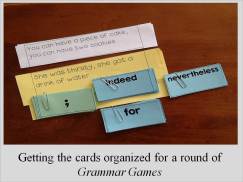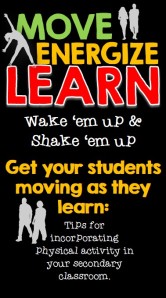Like many teachers across the country, I just spent the last two days in meetings. After a summer of relaxation and moving to the beat of my own wishes, I was required to sit for hours in a hard plastic chair while my well-intentioned principal droned on about the same information that he had written on the text-heavy slide show he was projecting. Every now and then we got a chance to question and discuss, but for the most part, we sat and listened. And squirmed, and doodled, and tuned out, and wished we were back on the beach. Afterward, many of us wondered about the wisdom of having sixty people who have been off for two months sit still all day.
Ironically, many of us will do that very same thing to our students today as we pass out schedules and drone on about procedure and rules. Like us, they will squirm, doodle and tune out as they try to get their minds and bodies ready to do it all every day of the semester. Like us, some of them will still learn despite their wish to be somewhere else. However, wouldn’t it be better if we could find ways to wake them up and to be active while they learn?
The human body is not designed to sit for long periods of time; yet, that is exactly what it does in school. In Brain Rules (2008) brain researcher John Medina states that “physical activity is cognitive candy” and that “exercise boosts brain power”. In fact, study after study points to the same conclusion: learners need to move. But is this research just about kinesthetic learners? Definitely not, for we all benefit from moving and stretching. It gets the blood flowing, it boosts creativity, and it breaks up the monotony of sitting in those hard old seats!
I’m lucky to teach with some creative and inspiring teachers who use lots of active learning in their classes. One physics and math teacher has a trunk full of toys and games that get students moving as they learn about the principles of physics. If you walk by his class on the right day, you might even witness students in egg throwing contests. His most popular game, though, is in his math class, where enthusiastic students play “Sig Fig Says” to learn about significant figures. Another math teacher has a chin up bar hanging from the ceiling so students can take action breaks, and a biology teacher has exercise balls for students to sit on so as to better engage their core. Others have taken students paint-balling to re-enact battles in WWII or the feud between the Montagues and Capulets. The students in these classes clearly have lots of opportunity to move to learn. But do you have to go to great lengths to get your students’ bodies and brains moving? Do you have to spend hours thinking up crazy lesson plans and field trips? No, because there are some very simple ideas that you can use every day. The simplest is to just allow students to stand up and stretch half way through the class. Or, when they do group work, tape a piece of chart paper on the wall so they have to do their work standing up. If you’re comfortable letting them leave the room, send them for a walk ‘n talk as they discuss their ideas. Send them in pairs or small groups for a walk around the school, or outside on the school grounds. You can find many of these ideas in my free product, by clicking on the image to the left.
 Last year, I also started developing a series of Grammar Games. I was soooo tired of correcting the same, basic grammar errors that I thought I’d try a more kinesthetic approach. I created cards containing parts of sentences that, when put together, form a grammatically correct sentence. I hand out the cards and then students have to find matches to help them complete their sentences. They have a great time running around the classroom, trying to be among the first to get a match. It makes grammar a little more fun, and I can give them immediate feedback without having to correct a bunch and exercises.
Last year, I also started developing a series of Grammar Games. I was soooo tired of correcting the same, basic grammar errors that I thought I’d try a more kinesthetic approach. I created cards containing parts of sentences that, when put together, form a grammatically correct sentence. I hand out the cards and then students have to find matches to help them complete their sentences. They have a great time running around the classroom, trying to be among the first to get a match. It makes grammar a little more fun, and I can give them immediate feedback without having to correct a bunch and exercises.
In a few weeks we will begin essay writing and I will use a very interactive approach to this, too, as students work together to develop ideas for an essay, and then create a “kinesthetic essay”. They activate all of their learning styles and, hopefully, better understand how to write an essay.
So today, when I meet my new students, I do have to give them a lot of information as we start the new year, but I plan to get them out of their seats so they don’t drift off to zombie land. And every day after that I will plan opportunities for my students to move and interact. The last two days of staff meetings served as a great reminder of how important these things are for engagement and learning!
Have an awesome new semester with your students. If you have any great ideas for active learning, please share them in the comments!

